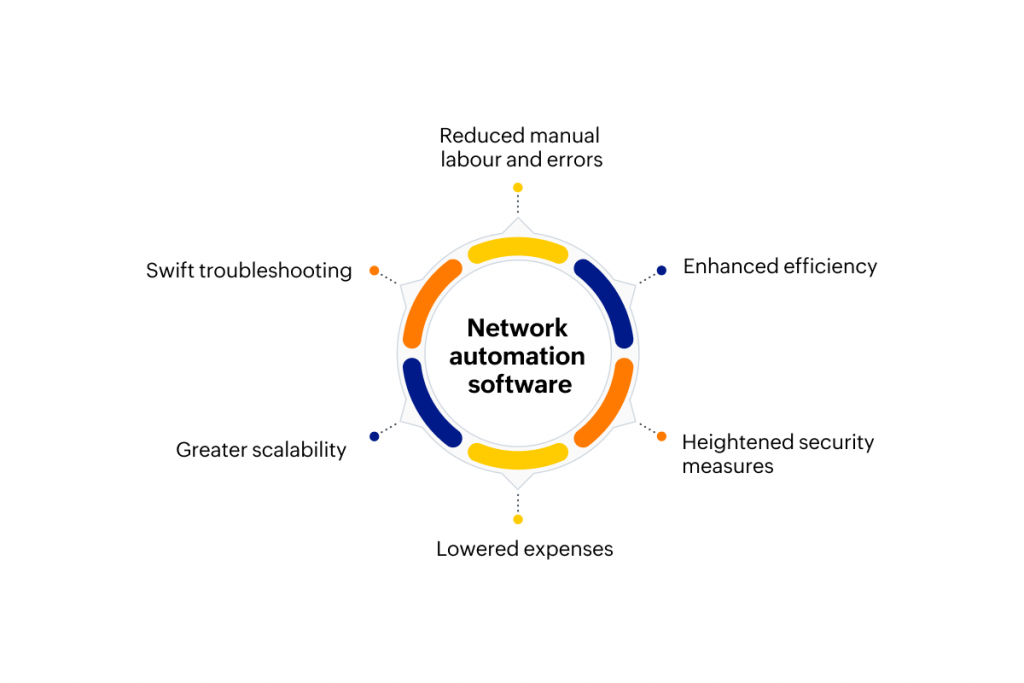Today, automation has shifted from being a luxury to an absolute necessity, especially within the realm of networks. This shift is driven by the rapid evolution of network technologies, compliance standards, and evolving business needs, placing an increasingly daunting burden on network administrators to manage these tasks manually.
IT admins always held a crucial role in ensuring a network’s agility and scalability, to meet the demands of end users who require high availability and reliability, which manual methods cannot consistently provide.
For instance, imagine a network administrator tasked with updating passwords in an environment with a thousand devices. Manually executing this task would require the administrator to log into each device individually and modify the credentials, a time-consuming endeavour. This process could potentially span over two to three days, consuming valuable time and resources.
Automation proves to be indispensable in this scenario, completing the given task in a matter of minutes. The time saved can significantly contribute to enhancing the scalability of your environment.
Now, the question arises: How can organizations swiftly implement automation for network tasks without incurring exorbitant costs? The answer is straightforward. All that’s needed is an affordable network automation software, that includes the essential functionalities demanded by the industry.
There is a plethora of network automation software options available, however they may be tailored to specific industries and potentially exclude others. With ManageEngine Network Configuration Manager as your network automation software, you gain access to all the industry-standard functionalities at a reasonable price, making it suitable for organizations of all sizes and across various industries.
According to Mordor Intelligence, the market size for network automation is expected to grow from USD 21.10 billion in 2023 to USD 50.82 billion by 2028, at a CAGR of 19.22% during the forecast period (2023-2028).

What you gain with a network automation software
- Minimizes the time dedicated to repetitive tasks and eradicates human error.
- Applies comprehensive authority over network configurations.
- Monitors, initiates, or reverses alterations made to your network.
- Ensures your organization maintains compliance through a streamlined automation process.
- Strengthens security measures and augments network dependability.
Must-have features for network automation software
- Automatically safeguards crucial network configurations for swift retrieval during network disasters.
- Monitors all configuration alterations in real time, eliminating the need for manual tracking.
- Schedules recurring tasks during non-office hours to prevent disruptions.
- Furnishes automation templates to implement configurations simultaneously or altering passwords on a thousand devices.
- Ensures device security through automated compliance checks and generates compliance reports at regular intervals.
- Effortlessly oversees firmware and addresses associated vulnerabilities.
- Delivers comprehensive reports with detailed insights.
- Allows for customization to align with your organization’s specific needs.
- Offers an intuitive and user-friendly interface for seamless operation.
Possessing 50-60% of these essential requirements could significantly improve your network’s resilience against disasters. However, envision having all 100% of these essential features. This could have an even more profound impact, liberating network administrators from their burdens and eliminating the manual errors that often lead to costly and time-sensitive network disasters.
How can you attain the full suite of essential requirements? It’s straightforward. Download and harness Network Configuration Manager as your network automation software.
Now, let’s delve deeper into the core automation functionalities of the software.
Network Configuration Manager: Your user-friendly network automation software
ManageEngine Network Configuration Manager is a versatile network configuration and change management (NCCM) software with multi-vendor support. It was meticulously crafted to automate and oversee the complete life cycle of device configuration management, effectively eliminating human errors and the possibility of network disasters.
In the event of an unavoidable network disaster, this software guarantees rapid disaster recovery within minutes, preventing any financial losses or damage to your organization’s reputation.
Core automation functionalities of this software
Some of the crucial automation functionalities of the software include:
- Automated configuration backup
- Real-time change tracking and alerts
- Automated script templates (Configlets)
- Compliance management
- Firmware vulnerability management
- Scheduling of critical tasks
- Comprehensive network reporting
Automated configuration backup
Backups play a crucial role in swiftly restoring the network during unforeseen downtime. However, in a large manual network setup, there’s a risk of backups not being consistently performed due to human error or oversight, potentially leading to disastrous consequences. With automated backups provided by Network Configuration Manager, administrators can rest assured, as the system autonomously conducts backups at regular intervals, mitigating this risk entirely. Automated backup works only when change detection is enabled for the required devices.
Here is an explanation of how automated backups function in Network Configuration Manager.
- When an admin, operator, or user logs in or out of a network device, the device generates a syslog message.
- These syslog messages are transmitted to the integrated syslog server within Network Configuration Manager, which actively monitors for logout messages.
- Upon receiving a logout message, Network Configuration Manager initiates a configuration backup for that specific network device. This precaution is taken because whenever someone logs out, there is a potential for them to have made alterations to the device’s configuration file.
- The newly backed-up configuration file is then compared with the most recent version stored in Network Configuration Manager. It is thoroughly inspected for any new modifications.
- If any changes are identified, the backed-up configuration file undergoes encryption and is securely stored in Network Configuration Manager’s database. If no changes are found, the backed-up file is promptly discarded.


